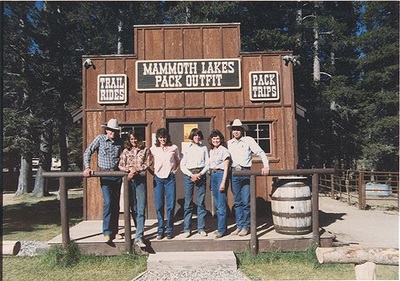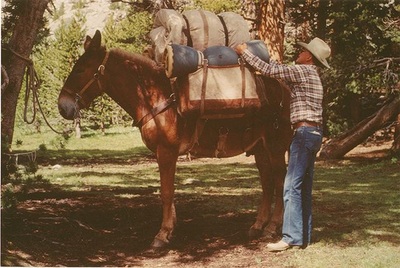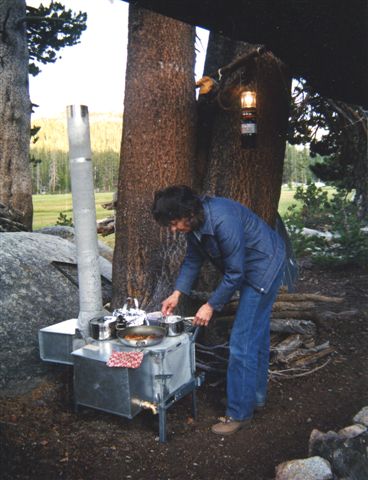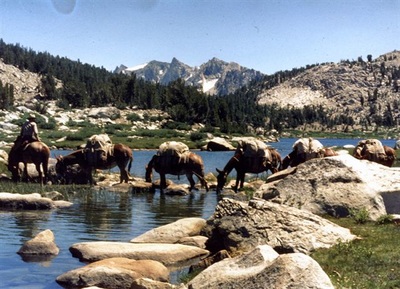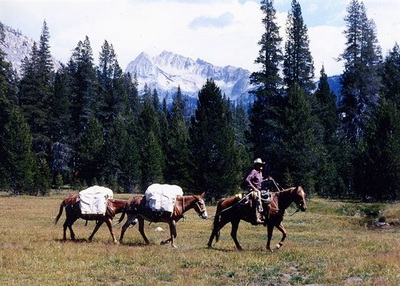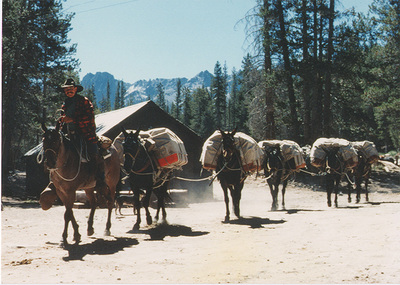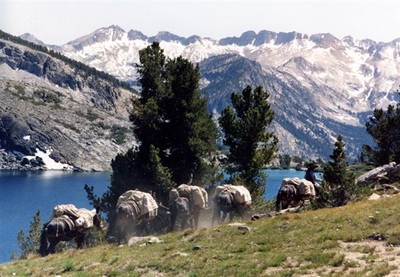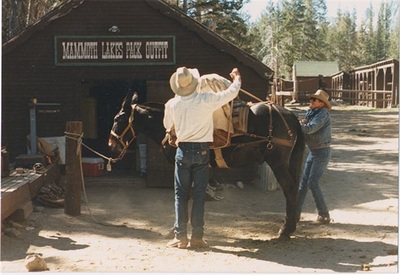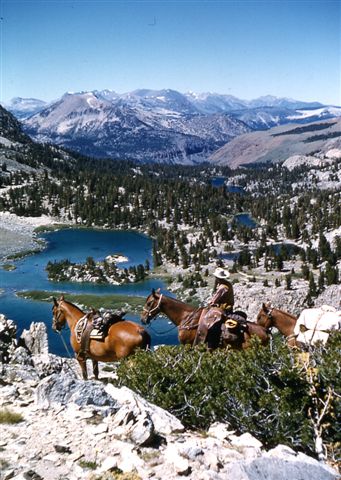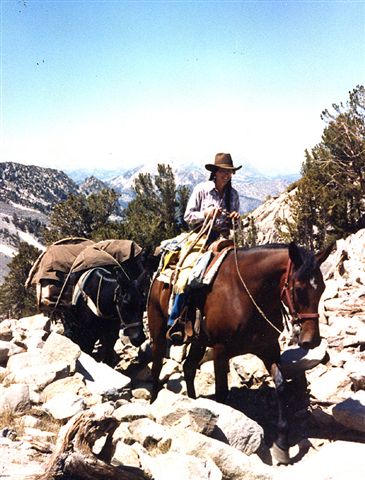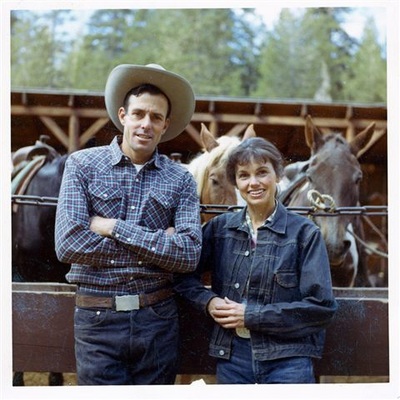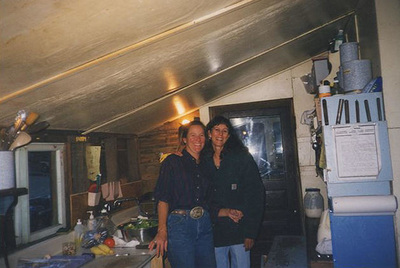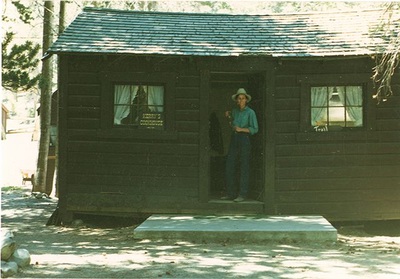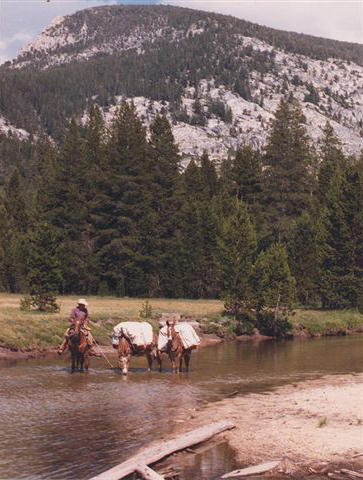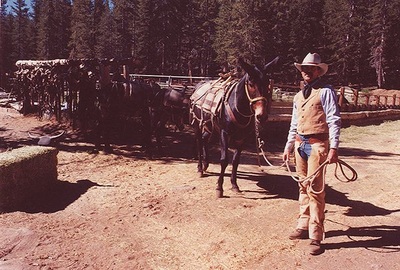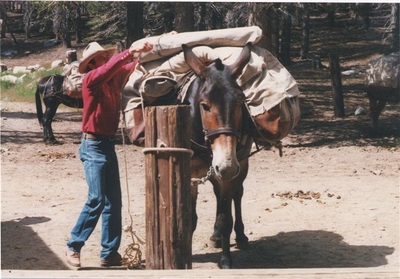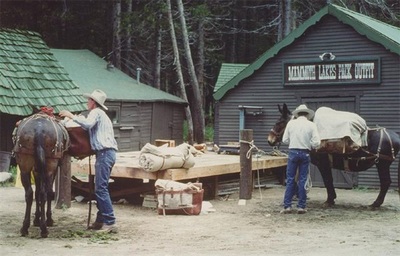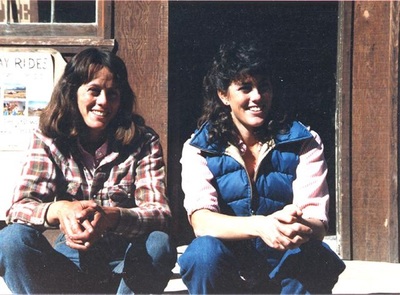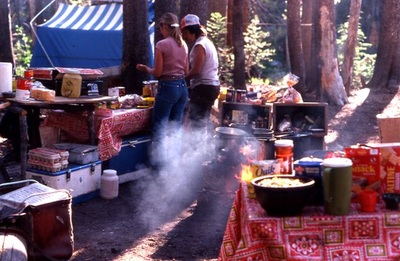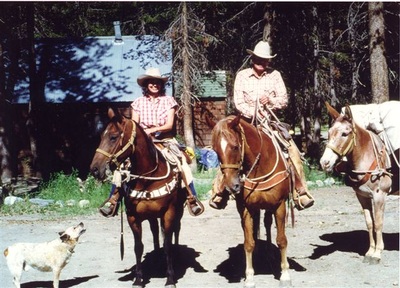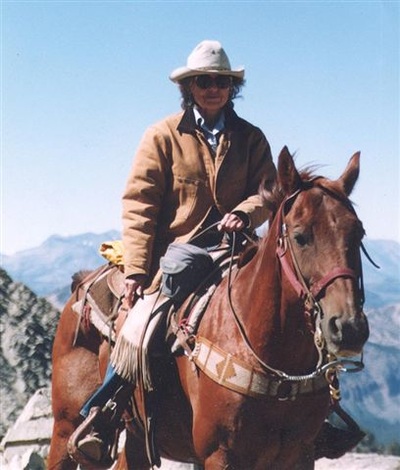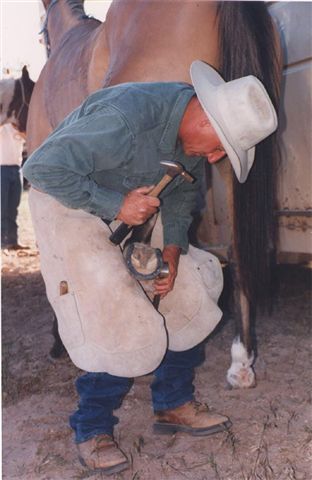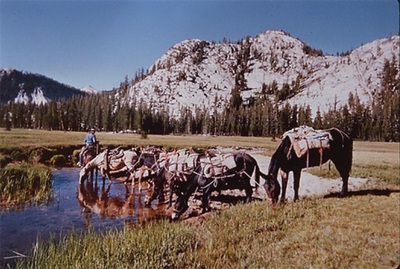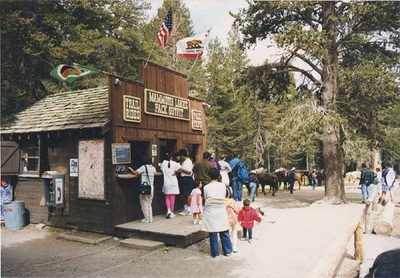A Brief History - Mammoth Lakes, CA
by Marye Roeser
SWITCHBACK TRAILS ACROSS THE SIERRA NEVADA:
A HISTORY OF COMMERCIAL PACK STATIONS BY MARYE ROESER
For most of my adult life, my husband and I have been a part of the commercial pack station scene in the Sierra. We have lived it, loved it and the mountains, and the people who made this industry an integral part of the Sierra Nevada cultural history. For years I collected bits of the colorful story and have finally woven this compelling interest into a recount of that previously, mostly unwritten history. After much research, writing and editing, the book is finished and almost ready for publication. The brief histories here are excerpts from that writing. As soon as the book is available for purchase, the information for acquiring a copy will be posted here. Happy Trails!!! Marye
A HISTORY OF COMMERCIAL PACK STATIONS BY MARYE ROESER
For most of my adult life, my husband and I have been a part of the commercial pack station scene in the Sierra. We have lived it, loved it and the mountains, and the people who made this industry an integral part of the Sierra Nevada cultural history. For years I collected bits of the colorful story and have finally woven this compelling interest into a recount of that previously, mostly unwritten history. After much research, writing and editing, the book is finished and almost ready for publication. The brief histories here are excerpts from that writing. As soon as the book is available for purchase, the information for acquiring a copy will be posted here. Happy Trails!!! Marye
|
The Mammoth Lakes Sierra is a wide opening in the Sierra Nevada Mountain front that is dominated by Mammoth Mountain, a volcano rising abruptly from the western edge of the Long Valley Caldera. A gap in the Sierra range allows Pacific storms from the gap in the Coast Range to flow across to the Mammoth area with more moisture and snows. This additional moisture created a Jeffrey pine forest extending toward the White Mountains that is the largest Jeffrey pine forest in the country. Another asset is the heavy snowfall that coats Mammoth Mountain making it a premier ski area in the country.
The Mammoth Lakes Basin is a glacial basin dotted with forested and alpine lakes that are bounded on the south and west by the precipitous Mammoth Crest or Rim. The waters from this basin, thousands of years ago, drained west into the San Joaquin River, but subsequent glaciations changed the course of the drainage to the east side of the range and into the Owens River. Lodges, resorts and the Mammoth Lakes Pack Outfit are located here as well as one the country’s largest ski resorts on Mammoth Mountain, the Mammoth Mountain Ski Area. Trails leading out of the basin and intersecting with the John Muir Trail are Duck Pass, the Mammoth Rim Trail and the Mammoth Pass Trail. These trails lead into Fish Creek Basin, a huge glacially carved basin with Fish Creek draining into the mighty San Joaquin River. Wooden packsaddles still creak in rhythm to the clink of steel horseshoes on rocky, granite trails leading into these craggy Sierra Nevada Mountains. Rugged packers carefully tend their sturdy mules carrying loads of supplies over narrow trails pioneered by Indian travelers and cattle and sheep men many years ago. The “mule packers” with their strings of saddle and pack animals look much the same today as they did in those days long past. The mule packing industry in the eastern High Sierra had its beginnings in the early 1860’s. The valley meadows were discovered by cattlemen and sheep men in the 1860’s and livestock owners moved their herds into the natural pastures for summer grazing. Long Valley with the Owens River flowing through it provided lush grazing for herds of cattle. From there, early cowboys moved stock into Fish Creek and the Middle Fork of the San Joaquin regions for high mountain grazing. Many of the early trails were built by livestock owners while driving their herds to and from summer grazing. Various bands of Northern Owens Valley Paiute Indians lived in the area during the summer months hunting, harvesting seeds and gathering willows for the superb baskets they constructed. Arrowheads, tools, grinding rocks and broken pieces of worked obsidian give evidence of their previous presence. The Paiute Indians traded extensively with the Miwok Indians from the west slope of the Sierra, meeting at Casa Diablo Hot Springs where they camped by the steaming springs. The trail across Mammoth Pass to the west was an important trade route with salt, obsidian and pinenuts traded in exchange for acorns, manzanita berries, and seashells brought by the western Miwoks. |
When gold was discovered on Red Mountain (first called Gold Mountain) in the 1870’s several small towns were established along the creeks. Mammoth City was located on the north side of Red Mountain while Mill City and Mineral Park were located further down the mountain toward the east. Pine City grew up along a little creek north of Lake Mary (then called Summit Lake). Log cabins quickly sprang up in Pine City, perhaps as many as twenty, along with a hotel, saloon and the Pine City Feed and Livery Stable. The site of old Pine City is located just north of Lake Mary, between Lake Mary and Twin Lakes. The livery stable was located approximately on the present site of the Mammoth Lakes Pack Outfit, and the owners advertised a corral with pasture attached, and hay and grain for sale in 1879.
The region was named after the Mammoth Mining Company incorporated in 1878. Owens Valley farms and ranches were established in the early 1860’s and pack strings and wagons supplied the new mining towns with produce and supplies climbing up Sherwin Grade. Mining equipment was also hauled up the grade to the new mines.
In 1878, J. S. French built a toll trail across the Sierra Nevada from the west; following old established Indian and livestock routes to the new strikes. The “French Trail” began at Fresno Flats (now the town of Oakhurst) 46 miles from Fresno, passed by such historic landmarks as Jackass Meadows, Clover Meadows, and Soldier Meadow and crossed the North Fork of the San Joaquin River. From there, the trail wound up the trail to King Creek and Summit Meadows, down to the Middle Fork of the San Joaquin River, over Mammoth Pass to Pine City and ended at Mammoth City. The trail was known by several names: the “French Trail”, the “Fresno Flats Trail” and the “Mammoth Pass Trail”.
French offered twice-weekly pack train service for riders from Fresno Flats to Mammoth for $15.00 and allowed up to 20 pounds of luggage. The Pine City Feed and Livery Stable also advertised regular pack train trips to Fresno Flats. The Fresno Flats Saddle Trains departed from the Monumental Hotel in Mammoth City on Tuesday and Friday, leaving at 5 AM for the 54-mile journey to Fresno Flats
As with other mining booms, the mines failed, and in 1881, the miners left, the towns declined and eventually disappeared. However, the old “French Trail” continued to be an important thoroughfare across the mountains used by livestock men driving their herds of cattle and sheep into the high mountains for summer grazing.
In the 1870’s Charlie and John Summers moved into this region and eventually purchased ranches in Long Valley, Bishop and the Mammoth Meadows. Charlie ranched along Laurel Creek and drove his cattle into Fish Creek for summer grazing. Charlie and his wife, Elizabeth, raised three sons, Lloyd, Len and “Young Charlie”. In 1911, Lloyd married Sybil McGee, daughter of early Long Valley pioneer cattleman, Alney McGee. The McGee ranch headquarters were on McGee Creek.
By 1915 or before, the Summers began packing in summer visitors to the magnificent backcountry lakes and streams. Mammoth Camp Pack Outfit was located in the Mammoth Meadows, below Mammoth Rock, and called Big Windy Flat by the early settlers. Early pack trips began at a big barn across the road from the Wildasin Hotel. In 1917, Charlie and Lloyd Summers purchased 160 acres of meadowland and the Wildasinn Hotel from Charlie Wildasinn who had homesteaded it. They constructed a beautiful new log hotel with additional guest cabins with logs cut from Twin Lakes.
The only road, at that time, into the Lakes basin was the original wagon road through Mammoth City to Pine City. The Summers established a corral on the south side of Lake Mary in a little meadow that was fenced. Horses and mules for pack trips could be trailed up the day prior to a trip and packers trailed sometimes twenty to thirty head of stock up the Old Mammoth Road from the meadows.
Pack trips traveled over Mammoth Pass via the Fresno Flats Trail to the pack station corrals near Red’s Meadow and the San Joaquin River. Other trips used the Duck Pass Trail to pack into the many lakes on the north side of the Pass. Trips then continued over the pass to Duck Lake, Purple Lake, Cascade Valley and Fish Creek.
There were ranches in the Mammoth Meadows, and one rancher, Tom Williams, drove his cattle over Mammoth Pass to Deer Creek for summer grazing. More summer cabins were built along Mammoth Creek and Charlie Summers established a store and a dairy there. The post office was in a corner of the store and Lloyd Summers was the postmaster. In 1919, the Forest Service announced plans to improve the old mining road to the lakes basin the following summer. The road from Mammoth Camp to Pine City would have no more than a 10% grade!
In 1923, there were still a dozen or so cabins standing in the mining town of Pine City just below Lake Mary. The old livery stable site of the Pine City Feed and Livery was part of the old town. Charlie Roberts began his pack station operation called Roberts Pack Train on this site and ran about 20 head of stock. He also had a corral at Pumice Flat on the San Joaquin River. He kept a pack of hounds for hunting bear and mountain lions.
In 1930, Roberts sold the pack station to a partnership of Don McGuffin, Ernie Smith, and Ed Brown. They called their station, Lake Mary Pack Train. In 1933, Don bought out his two partners. Included in the sale, were 58 horses and mules, 45 saddles and tack, 30 packsaddles and tack, and other packing and horse gear. The horses were branded Bar H on the left stifle. McGuffin worked at the Santa Anita Race Track during the winters.
Don McGuffin moved up several ranch buildings from the Bishop area in sections and put them back together again at the pack station. These were old ranch buildings that the Department of Water and Power of Los Angeles were going to destroy. As the City purchased Owens Valley ranches for their water rights, they often removed or burned the houses and barns as they did not want to become landlords. The kitchen (“cook shack”) and big saddle shed (barn) were two buildings that McGuffin moved to Lake Mary. The pack station buildings were located on the west side of the Lake Mary Road and across the little creek. Don had an office on the east side of the creek near the road and in 1934, he ran 45 head of stock.
McGuffin pioneered day ride trails to the top of Mammoth Mountain and to the top of Red Mountain where guests from the local lodges could ride horseback and admire the stunning views. This was long before there was a ski lift to the top of Mammoth Mountain.
By 1933 with a better road, the Mammoth Pack Outfit, owned by Lloyd Summers was now located across the road from the Lake Mary Pack Station. At this time, there were two pack stations across the road from each other and they both were busy! Lloyd Summers and his Mammoth Pack Outfit had established their pack station on the east side of the Lake Mary Road with cabins and corrals, and Don McGuffins’s Lake Mary Pack Train was on the west side of the road.
In 1937, a new Lake Mary Road location was established and construction begun. The new road was completed in 1939 providing easier access to the resorts in the Lakes Basin, but it by-passed the original Old Mammoth Road that steeply climbed up to the lakes basin and also the small community of Mammoth Camp. Those businesses had to move their establishments north to the new road to form a new community of Mammoth Lakes.
Lloyd Summers, the postmaster, had to move the post office to the new town. A building belonging to Summers was moved to that site to accommodate the post office. It served for many years and when the new post office was constructed in 1950, the old building was moved again and became the bunkhouse at the pack station where it stands today.
In 1932 Lloyd and Sybil Summers established the Red’s Meadow Pack Outfit. In 1933, Lloyd Summers advertised pack station locations at Mammoth Camp, Lake Mary, Red’s Meadow and Agnew Meadows. The outfit had been packing into Red’s Meadows and the San Joaquin River since 1915 and maintained a corral there. Lloyd’s brother, Charley and his family, managed the Agnew Meadows Pack Outfit. After a road was cut into Red’s Meadow, lumber was hauled down to the site and facilities begun. In 1935, Summers sold the Red’s Meadow Pack Station to Arch and Gladys Mahan while continuing to operate the other three outfits. Arch Mahan was a partner in the Mammoth Consolidated Mines that had recently ceased operations.
In 1939, Lloyd Summers purchased the Lake Mary Pack Station from McGuffin for $1,850.00 with $900.00 down. The bill of sale included 21 horses and mules, 2 cows, 35 saddles and tack, 20 packsaddles and gear, 1 corral and 3 cabins (1 was the barn). There were water rights also to Lake Mary and Cold Creek. Lloyd then merged the two stations into one, Mammoth Pack Outfit and moved their buildings to the west side of the road with the other pack station buildings. This is the present location of the pack station.
In 1940, Lloyd Summers advertised pack station locations, Mammoth Pack Outfit at Lake Mary and Mammoth Pack Outfit at Agnew Meadows. His brother Charley, still ran the pack outfit at Agnew Meadows, and Lloyd and Sybil and their three sons were at the Lake Mary outfit. During World War II, Lloyd’s two older sons served in the Service. Lee was stationed in Alaska and Verne was in the South Pacific. Lloyd and Sybil ran the pack station and on a busy August morning at 11:00 AM in 1945, as Lloyd was opening the dude horse corral gate and leading a horse, he suffered a fatal heart attack. Lee returned from Alaska and took over operation of the pack station the following season.
In 1946, the pack station was called, Summers’ Mammoth Lakes Pack Train. In 1946, Lee married Dorothy Douglas. Her father, Don Douglas, a teacher, packed at the station for a number of years. Lee’s son, Don, packed for his dad for several years and John Summers was born to Lee and Dorothy in 1950.
In 1954, Lee Summers had acquired a third interest in the Independence pasture lease called the Pool Field or the Tibault Lakes Field. The stock of three pack stations now wintered there: Mammoth Lakes Pack Outfit, Red’s Meadow Pack Station and Rock Creek Pack Station. Horse and mules were driven to and from the winter pasture. Mammoth Pack Outfit ran 80 head of stock, in 1957.
In 1952, a young Arizona cowboy, Lou Roeser, arrived at the pack station and was hired by Lee Summers for the summer packing season. Lou had run a dude string at a resort on Seeley Lake, Montana where he had been introduced to pack trips. He then worked on cattle ranches in Northern Arizona while attending the University of Arizona majoring in Animal Husbandry. After spring round up in 1952, he headed up Highway 395 toward eastern Oregon to find work on a cattle ranch. But, having heard about the Mammoth Lakes Pack Outfit and mule packing, when he reached the highway turnoff to Mammoth Lakes he decided to have a look at a High Sierra pack station. Little did he know then that he would spend the rest of his career packing in the Mammoth Lakes Sierra.
In Mammoth Lakes, Lou met his future wife, Marye Russell, who was working as Program Director at Camp High Sierra during summers while attending UCLA and majoring in Art. She guided the Camp High Sierra short rides out of the pack station as one of her camp duties and met Lou. They were married the following March of 1953 after Marye completed her teaching credential.
Lou and Mary worked the following two summers at McGee Creek Pack Station and two more summers at Rainbow Pack Outfit on Bishop Creek. They had determined that this occupation was what they wanted to do with their lives. Meanwhile, their oldest two children were born, Lee and Kerry.
In 1960, Lee Summers sold the Mammoth Lakes Pack Outfit to Lou and Marye Russell Roeser and Lou and Dorothy Russell Fitzhugh, with Lou Roeser, the managing partner. Marye and Dorothy are sisters. The new owners called the station, Mammoth Lakes Pack Outfit. The Independence pasture lease was included with the sale of the pack station. However, the stock was now trucked back and forth to the pack station from the winter pasture in Independence.
Lou had a building contractor’s license and immediately began remodeling and adding cabins, rebuilding corrals and adding a new packing shed and docks. When electricity arrived in the area in the middle 1960’s, outside lights by the corrals were great assets. Marye enjoyed a real refrigerator in the kitchen and a washing machine.
In 1964, Roeser was secretary of the Eastern High Sierra Packers’ Association and in the following year, he was president. A full schedule of day rides, half day rides and hour and two hour rides were instituted. All types of pack trips both for fishing and hunting were offered to the vacationing public.
By this time, the Roesers had four children, Lee, Kerry, Maryl and Leslie and the Fitzhughs had three children, Laurie, Ed and Jim. The younger generation with dusty cowboy hats and well scuffed boots were busy absorbing all the unique lore of pack station life in the High Sierra.
From 1964 to 1968, Mammoth Lakes Pack Outfit operated the Stables at the Mammoth Mountain Inn. Short horseback rides and dinner rides to Minaret Summit were provided to guests at the Inn.
In 1968, Lou Roeser was granted a Forest Service permit on 13 acres in old Mammoth to begin construction on a new equestrian center. Lou commenced building a new resort in the Mammoth Meadows. It began as a summer operation with horse boarding, hayrides, and short guided rides. In 1971, the first lodge building burned to the ground and Lou had to begin all over again rebuilding the lodge. In 1971, Roeser bought out the Fitzhughs’ interest in the Mammoth Lakes Pack Outfit.
After Lou had been a partner in managing a cattle and hay ranch, he and Marye purchased property in the Antelope Valley 85 miles north of Mammoth. The Roesers developed the ranch, raised some of the horses for the pack station, and personal horses were wintered there. Marye commenced teaching at Antelope Elementary School and Coleville High School during the winter months and taught for 20 years until 1987. She took early retirement after their youngest daughter, Leslie, was out of college, to spend more time on her painting career and further help with their expanding businesses.
Arnie Metcalf became a partner with Lou at Sierra Meadows, in 1976. The lodge and facilities was then expanded to a winter operation as well, with a full service cross-country ski center. The partners named the new business, Sierra Meadows Equestrian and Ski Touring Center.
In 1976, the pack outfit resumed horse drives from their Mammoth Lakes headquarters to winter pasture in Independence – this time including customers. With the advent of double deck cattle trucks, it was difficult to locate truckers to haul horses and mules. Horses and mules require more headroom! The bi-annual Spring and Fall 100 Mile Horse Drives became an important pack station tradition and event, and are continued today. The Spring and Fall Horse Drives are 5 days in length with 50 guests and 30 crew camping out along the trail. Horse Drives are quite different than cattle drives and are really a “hold them back” ride! The stock knows where they are going and are in a hurry to get there so the guests are a working part of the Drive.
In 1981 Metcalf left the partnership and Lou Roeser resumed management. He built a winterized barn in 1982, put in a restaurant kitchen and added sleigh rides and dinners. He then, purchased Mammoth Snowmobile Rentals and added snowmobile tours to the winter activities offered. Many employees worked both summer and winter for the outfit. In 1987 to 1989, Sierra Meadows put on Old West Days, Carriage Show and Carriage Drive over the 4th of July.
In 1977, Roeser acquired a Forest Service Outfitter-Guide Permit to run packing operations in the Bridgeport (Bridgeport Pack Trains) and Devil’s Gate area. Lou leased the Devil’s Gate Pack Station site on Highway 395 and purchased the Little Walker Pack Station site in Burt Canyon on the Little Walker River and ran pack trips out of there. Trail rides out of the wilderness were conducted to Bodie the Sweetwater Mountains, and Glass Mountains. In addition to horse drives, cattle drives and mustang viewing trips were added to the trip offerings.
The pack station had long been involved in filming in the region. Pack Station horses and mules appeared in North to Alaska, Ride the High Country, How the West was Won, Nevada Smith and Maverick to name a few. TV commercials were filmed in Mammoth and Lou supplied livestock, wagons, teams, cowboys, wranglers, arranged locations and accommodations. He soon began a long association with Marlboro and even appeared in several of their print ads. (He doesn’t smoke!) Mammoth Lakes Pack Outfit dude horses were photographed running through water and these photos became billboards.
Their son, Lee Roeser, had been packing since a boy and he and his sisters, Kerry, Maryl and Leslie were active working members of the pack station team. As the pack station grew with more activities, the siblings assumed management of many activities. Lee managed packing operations; Leslie and Kerry ran the day ride corral. More buildings, packing sheds and docks were added and cabins remodeled. Lou added a new office and day ride corrals by the road. By now, the pack station was running 120 head of stock.
In 1982, Lou and Marye Roeser were chosen “Most Honored Packers” at Mule Days in Bishop and Lou drove his surrey in the parade. Lou continued to be active in the Packers’ Association and was Vice President and on the Board of Directors many times. He was also active with the National Forest Recreation Association for many years on the board of directors.
In 1983 – 84, Roeser sub-leased the Convict Lake Stables and ran their short rides around the lake. Mammoth Lakes Pack Outfit had long conducted pack trips over Laurel Pass to the upper lakes in Convict Basin.
Lee married Jennifer Ketcham of McGee Creek Pack Station in 1988. Together, they purchased John Ketcham’s interest in McGee Creek Pack Station and operate it today. Lee became a skilled saddle maker and makes their pack gear and riding saddles as well as custom saddles for customers. He had been associated for years in the movie and film business with Lou, acquired a wranglers’ card, and has continued supplying film companies with livestock and equipment.
Kerry’s husband, Mike Elam and Leslie’s husband, Matt Engelhart both worked at the Mammoth Lakes Pack Outfit. Mike and Kerry have worked at McGee Creek Pack Station and Kerry continues there each summer. Her daughter, with dusty hat and well-scuffed boots, is absorbing pack station life and lore.
In 1992, after much thought, the Roesers sold Sierra Meadows Ranch and spent winters again at the ranch in Coleville. In 1998, they sold the Mammoth Lakes Pack Outfit, to John L. Summers, son of Lee and Dorothy Summers from whom Roeser had purchased the pack station from in 1960. John’s great grandfather, Charlie Summers, began the Mammoth Lakes packing operations so many years before and in almost 100 years, it has been owned by just the two families. John, a building contractor, has remodeled many of the buildings and is continuing the operation of the pack station and his family’s packing traditions. The Roesers (Lou, Marye and Maryl) are now retired to their horse ranch in Coleville where Marye maintains her painting studio.
In 2000, Lou and Marye were chosen to be Grand Marshals of the 4th of July parade in Mammoth Lakes. Lee rode with them with a pack string. The Bishop Mule Days Committee selected the Roeser family, as Best Friend of Mule Days in 2004 and all the family and four grandchildren rode in the parade and Jennifer Roeser led the 10 head matched mule string. Over the years, the pack station has competed each year in the Mule Days events, parade and shows. Lee Roeser is now President of Mule Days. Marye and Leslie Engelhart have an art booth at the Fairgrounds displaying and selling their western art.
The pack strings continue to wind their way up the switchbacks with echoes of the past around each curve of the trail. If one listens carefully, he might still hear ghostly packers calling to their mules, “Hey Rocky, pay attention and step lively! We’ll soon be in camp and green grass awaits you, with a cup of hot coffee for me.”
The region was named after the Mammoth Mining Company incorporated in 1878. Owens Valley farms and ranches were established in the early 1860’s and pack strings and wagons supplied the new mining towns with produce and supplies climbing up Sherwin Grade. Mining equipment was also hauled up the grade to the new mines.
In 1878, J. S. French built a toll trail across the Sierra Nevada from the west; following old established Indian and livestock routes to the new strikes. The “French Trail” began at Fresno Flats (now the town of Oakhurst) 46 miles from Fresno, passed by such historic landmarks as Jackass Meadows, Clover Meadows, and Soldier Meadow and crossed the North Fork of the San Joaquin River. From there, the trail wound up the trail to King Creek and Summit Meadows, down to the Middle Fork of the San Joaquin River, over Mammoth Pass to Pine City and ended at Mammoth City. The trail was known by several names: the “French Trail”, the “Fresno Flats Trail” and the “Mammoth Pass Trail”.
French offered twice-weekly pack train service for riders from Fresno Flats to Mammoth for $15.00 and allowed up to 20 pounds of luggage. The Pine City Feed and Livery Stable also advertised regular pack train trips to Fresno Flats. The Fresno Flats Saddle Trains departed from the Monumental Hotel in Mammoth City on Tuesday and Friday, leaving at 5 AM for the 54-mile journey to Fresno Flats
As with other mining booms, the mines failed, and in 1881, the miners left, the towns declined and eventually disappeared. However, the old “French Trail” continued to be an important thoroughfare across the mountains used by livestock men driving their herds of cattle and sheep into the high mountains for summer grazing.
In the 1870’s Charlie and John Summers moved into this region and eventually purchased ranches in Long Valley, Bishop and the Mammoth Meadows. Charlie ranched along Laurel Creek and drove his cattle into Fish Creek for summer grazing. Charlie and his wife, Elizabeth, raised three sons, Lloyd, Len and “Young Charlie”. In 1911, Lloyd married Sybil McGee, daughter of early Long Valley pioneer cattleman, Alney McGee. The McGee ranch headquarters were on McGee Creek.
By 1915 or before, the Summers began packing in summer visitors to the magnificent backcountry lakes and streams. Mammoth Camp Pack Outfit was located in the Mammoth Meadows, below Mammoth Rock, and called Big Windy Flat by the early settlers. Early pack trips began at a big barn across the road from the Wildasin Hotel. In 1917, Charlie and Lloyd Summers purchased 160 acres of meadowland and the Wildasinn Hotel from Charlie Wildasinn who had homesteaded it. They constructed a beautiful new log hotel with additional guest cabins with logs cut from Twin Lakes.
The only road, at that time, into the Lakes basin was the original wagon road through Mammoth City to Pine City. The Summers established a corral on the south side of Lake Mary in a little meadow that was fenced. Horses and mules for pack trips could be trailed up the day prior to a trip and packers trailed sometimes twenty to thirty head of stock up the Old Mammoth Road from the meadows.
Pack trips traveled over Mammoth Pass via the Fresno Flats Trail to the pack station corrals near Red’s Meadow and the San Joaquin River. Other trips used the Duck Pass Trail to pack into the many lakes on the north side of the Pass. Trips then continued over the pass to Duck Lake, Purple Lake, Cascade Valley and Fish Creek.
There were ranches in the Mammoth Meadows, and one rancher, Tom Williams, drove his cattle over Mammoth Pass to Deer Creek for summer grazing. More summer cabins were built along Mammoth Creek and Charlie Summers established a store and a dairy there. The post office was in a corner of the store and Lloyd Summers was the postmaster. In 1919, the Forest Service announced plans to improve the old mining road to the lakes basin the following summer. The road from Mammoth Camp to Pine City would have no more than a 10% grade!
In 1923, there were still a dozen or so cabins standing in the mining town of Pine City just below Lake Mary. The old livery stable site of the Pine City Feed and Livery was part of the old town. Charlie Roberts began his pack station operation called Roberts Pack Train on this site and ran about 20 head of stock. He also had a corral at Pumice Flat on the San Joaquin River. He kept a pack of hounds for hunting bear and mountain lions.
In 1930, Roberts sold the pack station to a partnership of Don McGuffin, Ernie Smith, and Ed Brown. They called their station, Lake Mary Pack Train. In 1933, Don bought out his two partners. Included in the sale, were 58 horses and mules, 45 saddles and tack, 30 packsaddles and tack, and other packing and horse gear. The horses were branded Bar H on the left stifle. McGuffin worked at the Santa Anita Race Track during the winters.
Don McGuffin moved up several ranch buildings from the Bishop area in sections and put them back together again at the pack station. These were old ranch buildings that the Department of Water and Power of Los Angeles were going to destroy. As the City purchased Owens Valley ranches for their water rights, they often removed or burned the houses and barns as they did not want to become landlords. The kitchen (“cook shack”) and big saddle shed (barn) were two buildings that McGuffin moved to Lake Mary. The pack station buildings were located on the west side of the Lake Mary Road and across the little creek. Don had an office on the east side of the creek near the road and in 1934, he ran 45 head of stock.
McGuffin pioneered day ride trails to the top of Mammoth Mountain and to the top of Red Mountain where guests from the local lodges could ride horseback and admire the stunning views. This was long before there was a ski lift to the top of Mammoth Mountain.
By 1933 with a better road, the Mammoth Pack Outfit, owned by Lloyd Summers was now located across the road from the Lake Mary Pack Station. At this time, there were two pack stations across the road from each other and they both were busy! Lloyd Summers and his Mammoth Pack Outfit had established their pack station on the east side of the Lake Mary Road with cabins and corrals, and Don McGuffins’s Lake Mary Pack Train was on the west side of the road.
In 1937, a new Lake Mary Road location was established and construction begun. The new road was completed in 1939 providing easier access to the resorts in the Lakes Basin, but it by-passed the original Old Mammoth Road that steeply climbed up to the lakes basin and also the small community of Mammoth Camp. Those businesses had to move their establishments north to the new road to form a new community of Mammoth Lakes.
Lloyd Summers, the postmaster, had to move the post office to the new town. A building belonging to Summers was moved to that site to accommodate the post office. It served for many years and when the new post office was constructed in 1950, the old building was moved again and became the bunkhouse at the pack station where it stands today.
In 1932 Lloyd and Sybil Summers established the Red’s Meadow Pack Outfit. In 1933, Lloyd Summers advertised pack station locations at Mammoth Camp, Lake Mary, Red’s Meadow and Agnew Meadows. The outfit had been packing into Red’s Meadows and the San Joaquin River since 1915 and maintained a corral there. Lloyd’s brother, Charley and his family, managed the Agnew Meadows Pack Outfit. After a road was cut into Red’s Meadow, lumber was hauled down to the site and facilities begun. In 1935, Summers sold the Red’s Meadow Pack Station to Arch and Gladys Mahan while continuing to operate the other three outfits. Arch Mahan was a partner in the Mammoth Consolidated Mines that had recently ceased operations.
In 1939, Lloyd Summers purchased the Lake Mary Pack Station from McGuffin for $1,850.00 with $900.00 down. The bill of sale included 21 horses and mules, 2 cows, 35 saddles and tack, 20 packsaddles and gear, 1 corral and 3 cabins (1 was the barn). There were water rights also to Lake Mary and Cold Creek. Lloyd then merged the two stations into one, Mammoth Pack Outfit and moved their buildings to the west side of the road with the other pack station buildings. This is the present location of the pack station.
In 1940, Lloyd Summers advertised pack station locations, Mammoth Pack Outfit at Lake Mary and Mammoth Pack Outfit at Agnew Meadows. His brother Charley, still ran the pack outfit at Agnew Meadows, and Lloyd and Sybil and their three sons were at the Lake Mary outfit. During World War II, Lloyd’s two older sons served in the Service. Lee was stationed in Alaska and Verne was in the South Pacific. Lloyd and Sybil ran the pack station and on a busy August morning at 11:00 AM in 1945, as Lloyd was opening the dude horse corral gate and leading a horse, he suffered a fatal heart attack. Lee returned from Alaska and took over operation of the pack station the following season.
In 1946, the pack station was called, Summers’ Mammoth Lakes Pack Train. In 1946, Lee married Dorothy Douglas. Her father, Don Douglas, a teacher, packed at the station for a number of years. Lee’s son, Don, packed for his dad for several years and John Summers was born to Lee and Dorothy in 1950.
In 1954, Lee Summers had acquired a third interest in the Independence pasture lease called the Pool Field or the Tibault Lakes Field. The stock of three pack stations now wintered there: Mammoth Lakes Pack Outfit, Red’s Meadow Pack Station and Rock Creek Pack Station. Horse and mules were driven to and from the winter pasture. Mammoth Pack Outfit ran 80 head of stock, in 1957.
In 1952, a young Arizona cowboy, Lou Roeser, arrived at the pack station and was hired by Lee Summers for the summer packing season. Lou had run a dude string at a resort on Seeley Lake, Montana where he had been introduced to pack trips. He then worked on cattle ranches in Northern Arizona while attending the University of Arizona majoring in Animal Husbandry. After spring round up in 1952, he headed up Highway 395 toward eastern Oregon to find work on a cattle ranch. But, having heard about the Mammoth Lakes Pack Outfit and mule packing, when he reached the highway turnoff to Mammoth Lakes he decided to have a look at a High Sierra pack station. Little did he know then that he would spend the rest of his career packing in the Mammoth Lakes Sierra.
In Mammoth Lakes, Lou met his future wife, Marye Russell, who was working as Program Director at Camp High Sierra during summers while attending UCLA and majoring in Art. She guided the Camp High Sierra short rides out of the pack station as one of her camp duties and met Lou. They were married the following March of 1953 after Marye completed her teaching credential.
Lou and Mary worked the following two summers at McGee Creek Pack Station and two more summers at Rainbow Pack Outfit on Bishop Creek. They had determined that this occupation was what they wanted to do with their lives. Meanwhile, their oldest two children were born, Lee and Kerry.
In 1960, Lee Summers sold the Mammoth Lakes Pack Outfit to Lou and Marye Russell Roeser and Lou and Dorothy Russell Fitzhugh, with Lou Roeser, the managing partner. Marye and Dorothy are sisters. The new owners called the station, Mammoth Lakes Pack Outfit. The Independence pasture lease was included with the sale of the pack station. However, the stock was now trucked back and forth to the pack station from the winter pasture in Independence.
Lou had a building contractor’s license and immediately began remodeling and adding cabins, rebuilding corrals and adding a new packing shed and docks. When electricity arrived in the area in the middle 1960’s, outside lights by the corrals were great assets. Marye enjoyed a real refrigerator in the kitchen and a washing machine.
In 1964, Roeser was secretary of the Eastern High Sierra Packers’ Association and in the following year, he was president. A full schedule of day rides, half day rides and hour and two hour rides were instituted. All types of pack trips both for fishing and hunting were offered to the vacationing public.
By this time, the Roesers had four children, Lee, Kerry, Maryl and Leslie and the Fitzhughs had three children, Laurie, Ed and Jim. The younger generation with dusty cowboy hats and well scuffed boots were busy absorbing all the unique lore of pack station life in the High Sierra.
From 1964 to 1968, Mammoth Lakes Pack Outfit operated the Stables at the Mammoth Mountain Inn. Short horseback rides and dinner rides to Minaret Summit were provided to guests at the Inn.
In 1968, Lou Roeser was granted a Forest Service permit on 13 acres in old Mammoth to begin construction on a new equestrian center. Lou commenced building a new resort in the Mammoth Meadows. It began as a summer operation with horse boarding, hayrides, and short guided rides. In 1971, the first lodge building burned to the ground and Lou had to begin all over again rebuilding the lodge. In 1971, Roeser bought out the Fitzhughs’ interest in the Mammoth Lakes Pack Outfit.
After Lou had been a partner in managing a cattle and hay ranch, he and Marye purchased property in the Antelope Valley 85 miles north of Mammoth. The Roesers developed the ranch, raised some of the horses for the pack station, and personal horses were wintered there. Marye commenced teaching at Antelope Elementary School and Coleville High School during the winter months and taught for 20 years until 1987. She took early retirement after their youngest daughter, Leslie, was out of college, to spend more time on her painting career and further help with their expanding businesses.
Arnie Metcalf became a partner with Lou at Sierra Meadows, in 1976. The lodge and facilities was then expanded to a winter operation as well, with a full service cross-country ski center. The partners named the new business, Sierra Meadows Equestrian and Ski Touring Center.
In 1976, the pack outfit resumed horse drives from their Mammoth Lakes headquarters to winter pasture in Independence – this time including customers. With the advent of double deck cattle trucks, it was difficult to locate truckers to haul horses and mules. Horses and mules require more headroom! The bi-annual Spring and Fall 100 Mile Horse Drives became an important pack station tradition and event, and are continued today. The Spring and Fall Horse Drives are 5 days in length with 50 guests and 30 crew camping out along the trail. Horse Drives are quite different than cattle drives and are really a “hold them back” ride! The stock knows where they are going and are in a hurry to get there so the guests are a working part of the Drive.
In 1981 Metcalf left the partnership and Lou Roeser resumed management. He built a winterized barn in 1982, put in a restaurant kitchen and added sleigh rides and dinners. He then, purchased Mammoth Snowmobile Rentals and added snowmobile tours to the winter activities offered. Many employees worked both summer and winter for the outfit. In 1987 to 1989, Sierra Meadows put on Old West Days, Carriage Show and Carriage Drive over the 4th of July.
In 1977, Roeser acquired a Forest Service Outfitter-Guide Permit to run packing operations in the Bridgeport (Bridgeport Pack Trains) and Devil’s Gate area. Lou leased the Devil’s Gate Pack Station site on Highway 395 and purchased the Little Walker Pack Station site in Burt Canyon on the Little Walker River and ran pack trips out of there. Trail rides out of the wilderness were conducted to Bodie the Sweetwater Mountains, and Glass Mountains. In addition to horse drives, cattle drives and mustang viewing trips were added to the trip offerings.
The pack station had long been involved in filming in the region. Pack Station horses and mules appeared in North to Alaska, Ride the High Country, How the West was Won, Nevada Smith and Maverick to name a few. TV commercials were filmed in Mammoth and Lou supplied livestock, wagons, teams, cowboys, wranglers, arranged locations and accommodations. He soon began a long association with Marlboro and even appeared in several of their print ads. (He doesn’t smoke!) Mammoth Lakes Pack Outfit dude horses were photographed running through water and these photos became billboards.
Their son, Lee Roeser, had been packing since a boy and he and his sisters, Kerry, Maryl and Leslie were active working members of the pack station team. As the pack station grew with more activities, the siblings assumed management of many activities. Lee managed packing operations; Leslie and Kerry ran the day ride corral. More buildings, packing sheds and docks were added and cabins remodeled. Lou added a new office and day ride corrals by the road. By now, the pack station was running 120 head of stock.
In 1982, Lou and Marye Roeser were chosen “Most Honored Packers” at Mule Days in Bishop and Lou drove his surrey in the parade. Lou continued to be active in the Packers’ Association and was Vice President and on the Board of Directors many times. He was also active with the National Forest Recreation Association for many years on the board of directors.
In 1983 – 84, Roeser sub-leased the Convict Lake Stables and ran their short rides around the lake. Mammoth Lakes Pack Outfit had long conducted pack trips over Laurel Pass to the upper lakes in Convict Basin.
Lee married Jennifer Ketcham of McGee Creek Pack Station in 1988. Together, they purchased John Ketcham’s interest in McGee Creek Pack Station and operate it today. Lee became a skilled saddle maker and makes their pack gear and riding saddles as well as custom saddles for customers. He had been associated for years in the movie and film business with Lou, acquired a wranglers’ card, and has continued supplying film companies with livestock and equipment.
Kerry’s husband, Mike Elam and Leslie’s husband, Matt Engelhart both worked at the Mammoth Lakes Pack Outfit. Mike and Kerry have worked at McGee Creek Pack Station and Kerry continues there each summer. Her daughter, with dusty hat and well-scuffed boots, is absorbing pack station life and lore.
In 1992, after much thought, the Roesers sold Sierra Meadows Ranch and spent winters again at the ranch in Coleville. In 1998, they sold the Mammoth Lakes Pack Outfit, to John L. Summers, son of Lee and Dorothy Summers from whom Roeser had purchased the pack station from in 1960. John’s great grandfather, Charlie Summers, began the Mammoth Lakes packing operations so many years before and in almost 100 years, it has been owned by just the two families. John, a building contractor, has remodeled many of the buildings and is continuing the operation of the pack station and his family’s packing traditions. The Roesers (Lou, Marye and Maryl) are now retired to their horse ranch in Coleville where Marye maintains her painting studio.
In 2000, Lou and Marye were chosen to be Grand Marshals of the 4th of July parade in Mammoth Lakes. Lee rode with them with a pack string. The Bishop Mule Days Committee selected the Roeser family, as Best Friend of Mule Days in 2004 and all the family and four grandchildren rode in the parade and Jennifer Roeser led the 10 head matched mule string. Over the years, the pack station has competed each year in the Mule Days events, parade and shows. Lee Roeser is now President of Mule Days. Marye and Leslie Engelhart have an art booth at the Fairgrounds displaying and selling their western art.
The pack strings continue to wind their way up the switchbacks with echoes of the past around each curve of the trail. If one listens carefully, he might still hear ghostly packers calling to their mules, “Hey Rocky, pay attention and step lively! We’ll soon be in camp and green grass awaits you, with a cup of hot coffee for me.”
